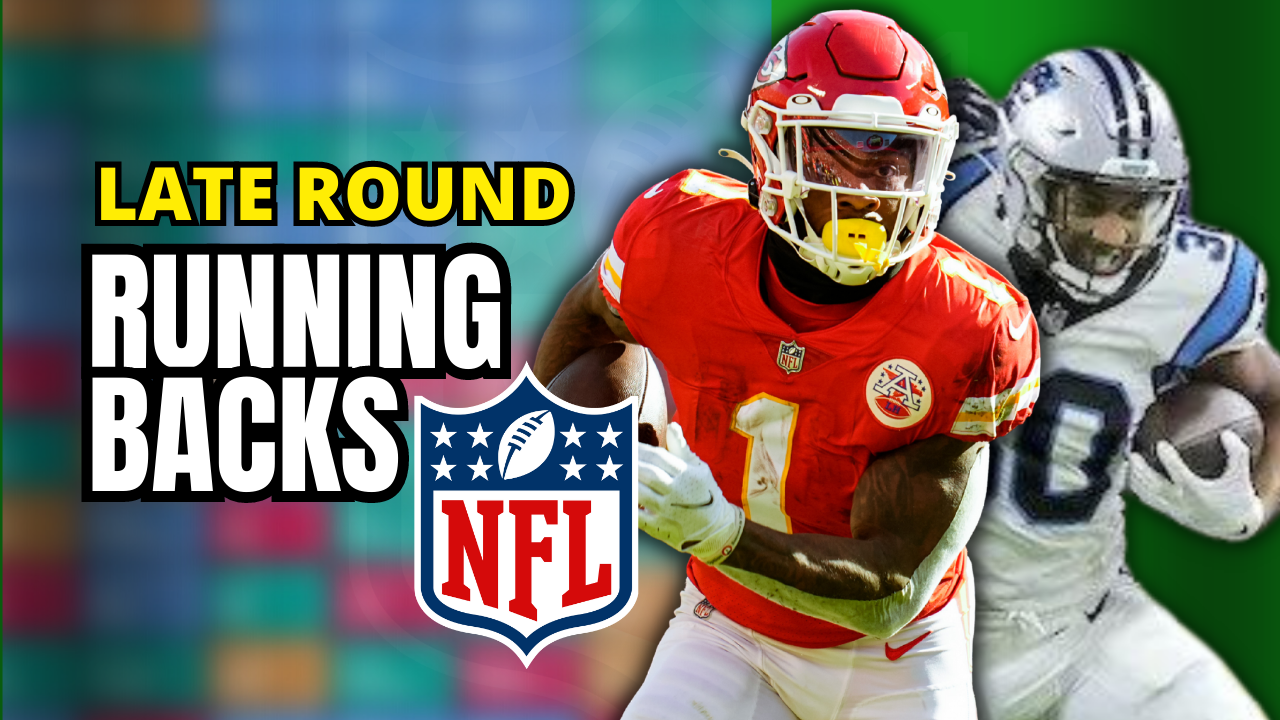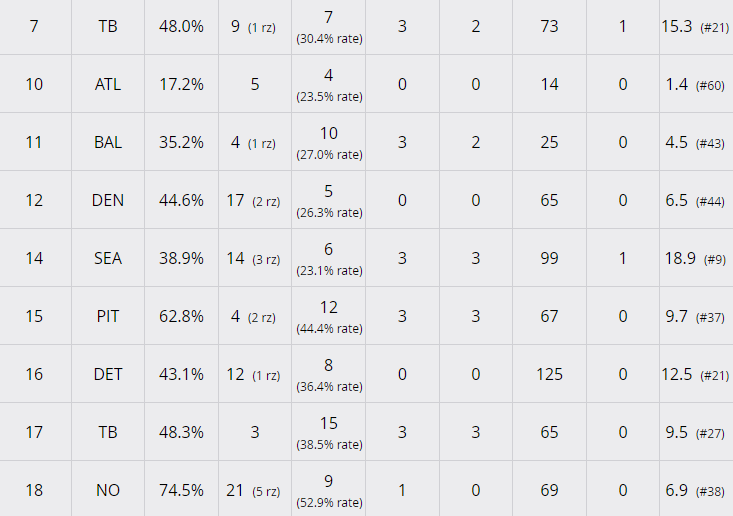
Late Round Running Backs You Need To Know In 2023
2023 Late Round Running Backs
Everyone loves a late round steal. They cost virtually nothing and could be the difference between falling short of a championship and bringing home gold. In my personal opinion, taking late round stabs on running back is the best way to go. They tend to have the easiest path to seeing a big increase in projected workload.
When a team’s top receiver goes down, the next guy in line doesn’t simply absorb all of the targets. It gets spread out, usually ending up with 3-4 guys getting an extra couple of targets each. Backup quarterbacks, for the most part, aren’t worth starting unless time’s are really tough. Tight ends usually don’t take on the starter’s target share either, unless it is an ambiguous group to begin with. However, if a starting running back either gets hurt or fails to meet expectations, a majority of that work usually falls onto the next guy. Look at the Chiefs and Patriots, for example.
Injuries and inefficiency hurt both Clyde Edwards-Helaire and Damien Harris. Meanwhile, Isaiah Pacheco averaged 83 yards over the final nine games of the regular season and Rhamondre Stevenson finished as the RB7. The opportunity for backup running backs to become viable fantasy options is much better than any other position.
Last year, I gave out Jamaal Williams as one of my late round targets. He went on to finish as the RB13 on the year, putting up 16 or more points SEVEN times. For a guy who was being drafted in the double digit rounds, I would say that’s a win. So with that being said, here are my two favorite late round targets at the running back position.
Jerick McKinnon
If you knew a running back had just 72 carries in a season, you probably wouldn’t think much of it. However, what if I told you that he only had one less target than he had carries? I assume you would change your tune. Well, Jerick McKinnon did just that in 2022.
His analytical numbers are a thing of beauty, as evidenced by the graphics below from Player Profiler. He was in the top 20 of every listed stat outside of Dominator Rating and Run Blocking Rating. His volume stats and his efficiency stats both being that high is a great combination to have. The fact that those numbers are attached to a player being drafted in the double digit rounds should be all you need to hear for McKinnon’s upside.


Granted, his RB20 finish last season was greatly aided by his 10 total touchdowns. Yes, that number is likely to come down a good bit. However, even if he had half the amount of touchdowns, he would have still been the RB28. I do expect Isiah Pacheco to take on a little bit more of the receiving work in his second season, and a healthy Clyde Edwards-Helaire could also see a bit of work. I would argue that his RB45 ADP is already baking in those factors.
Now time for some hypotheticals. Let’s say Pacheco and Edwards-Helaire take 15 targets each from McKinnon. His remaining 41 targets, at his career 74-percent catch rate, would net him 31 receptions. Take that by his 8.9 yards per reception as a Chief, and you get 276 yards. A stat line of 31 receptions, 276 yards (plus, let’s say, 150 rushing yards), and five touchdowns would have put him right at the RB45 this past season. This new stat-line is contingent on Pacheco and Edwards-Helaire both stealing 15 targets from him. Half of his total touchdown would also need to vanish, and both players would need to stay healthy for a full 17 games, which Edwards-Helaire has yet to do in the first three years of his career.
I know it may seem a bit scary to draft a player who could conceivably split backfield touches with two other players, but with his ADP being so low, the potential upside is worth the risk. If Pacheco has a sophomore slump and/or Edwards-Helaire continues to deal with injuries, McKinnon will likely see production similar to what he had last season. Worst case scenario (barring injury), you draft a player right around the area that he finishes the season at. Best case scenario, the Pacheco slump or Edwards-Helaire injury comes to fruition, and you have the pass-catching running back in an elite offense.
Chuba Hubbard
In his first two years in the NFL, Hubbard has proven that he can be a solid option at running back. Whether it be in a complimentary role or as a fill-in for an injured starter (i.e. Christian McCaffrey in 2021), he has done well with the workload given to him. His underlying numbers show that, when given the opportunity, he is an effective weapon.
The graphic below shows how much his usage spiked after the McCaffrey trade. Prior to the trade, he had just one week with a double-digit usage rate. As you can see in the chart, that number was below 35-percent just once after the trade. That one week was his first week back from a sprained ankle. He also averaged nine routes run and 10.5 fantasy points per game after the trade, compared to 2.3 routes run and a measly 0.4 fantasy points per game prior to the trade. That pace over 17 games would have made him the RB23 last season.

His 4.6 true yards per carry last season ranked 17th in the league, while his 5.8 yards per touch was sixth amongst running backs. Although he saw just 109 touches in 2022, he turned them into a respectable 637 total yards. There is a major reason to believe that his touches in 2023 could jump a significant amount. That reason is the Panthers’ new running backs coach, Duce Staley.
Staley has been a running backs coach for the past 10 seasons, spending eight years with the Eagles and two with the Lions. In those 10 seasons, he has only had six running backs reach 200 total touches in a season. Two of those seasons were when LeSean McCoy was arguably the best running back in the league. A third season was when Jordan Howard missed seven games, which allowed Miles Sanders to take more of a workload and reach 229 touches.
On top of that, only three of Staley’s 10 seasons have had the secondary running back not reach 100 touches. Two of those were the previously mentioned McCoy seasons, and the third was when they traded for Jay Ajayi halfway into the season (he and Corey Clement both got 80-plus touches). All of this is to say, the Panthers will likely use at least a two-headed backfield in 2023.
Hypothetical time again. For this exercise, I will exclude the two years where McCoy dominated the touches because, with all due respect, Miles Sanders is not LeSean McCoy. The RB2 in a Duce Staley backfield has seen, on average, 129 touches per season. If Hubbard saw that many touches, times his 5.8 yards per touch last season, he would have 748 yards. Add in a handful more receptions (let’s say 20 total) and a couple extra touchdowns (I’ll do six total) due to the increase in touches, and it comes out to 130.8 fantasy points. That would have been good for an RB37 finish last year.
I know, it doesn’t sound exciting. However, when you take into account his current ADP (RB58 and 180th overall), he is nearly free in 12-team leagues. Worst case scenario (barring injury), he puts up the same numbers as last season and gives you a few weeks of starting level production (five weeks of nine or more points in 2022). Best case scenario, Hubbard sees closer to 40-percent of the backfield touches and he becomes a weekly flex option. Either way, I certainly won’t complain about drafting a borderline RB3 with upside in the last few rounds of my drafts.
RANKINGS | DYNASTY | REDRAFT | ROOKIES
 Draft With Us On Underdog! Use Promo-Code: YARDSPER to double your deposit!
Draft With Us On Underdog! Use Promo-Code: YARDSPER to double your deposit!




